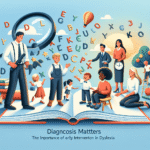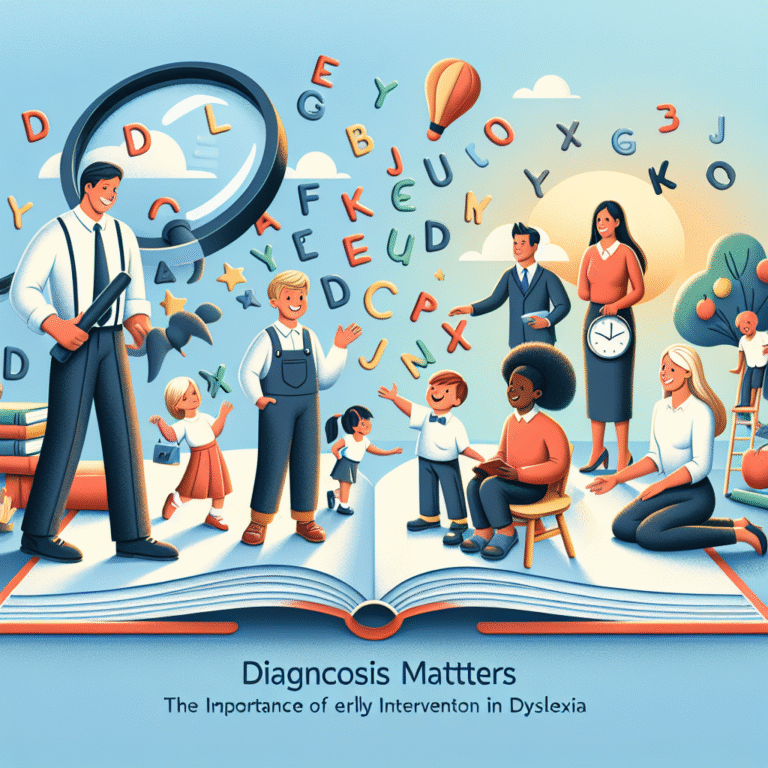
Diagnosis Matters: The Essential Role of Early Intervention in Dyslexia
Introduction
Imagine a child sitting at a desk, struggling with words that seem to dance on the page. Despite their intelligence and potential, they may face an uphill battle if dyslexia goes undiagnosed. The adage “Diagnosis Matters” rings especially true in this context—highlighting how critical early detection and intervention can be in transforming the educational and personal trajectories of children with dyslexia. In this article, we will explore why understanding and addressing dyslexia early on is not just beneficial but essential.
Understanding Dyslexia: What You Need to Know
What Is Dyslexia?
Dyslexia is a specific learning disorder that affects reading skills. It is characterized by difficulties in phonological awareness, verbal memory, and processing speed. This neurological condition is often misidentified as a lack of intelligence or effort, leading to misconceptions and inadequate support.
Signs and Symptoms of Dyslexia
Understanding the signs of dyslexia is the first step toward effective intervention. Early indicators can include:
- Difficulty recognizing letters and words.
- Problems with spelling and writing.
- Challenges in learning the alphabet.
- Trouble with retaining information presented orally.
Awareness of these signs allows for timely diagnosis and paves the way for proper support.
The Importance of Early Diagnosis
Diagnosis Matters: The Importance of Early Intervention in Dyslexia cannot be overstated. Research shows that children identified with dyslexia at a younger age benefit significantly from targeted educational strategies. Early diagnosis can mitigate the emotional and academic challenges that often accompany dyslexia.
The Impact of Early Intervention
Academic Performance
Early intervention programs can substantially improve reading skills. According to a study published in the journal "Child Development," children who received early reading intervention showed an increase in proficiency, enabling them to catch up with their peers.
Case Study: The Hughes Family
The Hughes family discovered their son, Jacob, had dyslexia at age six. With early intervention through a specialized reading program, Jacob was able to improve his reading skills dramatically. By age eight, he was not only reading at grade level but also participating actively in class discussions.
Analysis: Jacob’s case emphasizes the transformative power of early diagnosis and intervention. His proactive approach set a positive trajectory for his future, showcasing that timely support can yield remarkable improvements.
Emotional Well-Being
Children with dyslexia often face feelings of inadequacy, frustration, and anxiety. Early intervention addresses not only the academic aspects but also the emotional and social facets of a child’s life.
Case Study: Emma’s Journey
When Emma was diagnosed with dyslexia, her parents opted for early intervention that included counseling and reading support. Over time, Emma not only became a confident reader but also improved her self-esteem.
Analysis: Emma’s story illustrates the holistic benefits of early intervention. By focusing on both academic skills and emotional support, she was empowered to thrive both in and out of the classroom.
Effective Strategies and Techniques for Early Intervention
Structured Literacy Programs
Structured literacy approaches, such as the Orton-Gillingham method, are particularly effective for children with dyslexia. These programs involve explicit instruction in phonics, decoding, and comprehension.
One-on-One Tutoring
Personalized one-on-one tutoring can significantly accelerate a child’s reading ability. Tutors trained in dyslexia-specific strategies can adapt their methods to suit each child’s unique learning style.
Collaborative Support Systems
Creating a network of support involving teachers, parents, and specialists is crucial. Regular meetings and communication ensure a cohesive approach to the child’s learning journey.
The Role of Schools and Educators
Training Educators
Schools must prioritize training educators to recognize the signs of dyslexia. Educators equipped with the knowledge and tools to support children can make a massive difference in their experiences.
Implementing IEPs and 504 Plans
Individualized Education Programs (IEPs) and 504 plans are vital in ensuring that children with dyslexia receive the accommodations they need. These plans formalize the support structure and provide a roadmap for success.
Advocacy and Awareness
Raising awareness in schools about dyslexia is essential. Events, workshops, and discussion forums can foster understanding and build community support.
Overcoming Common Misconceptions
Despite growing knowledge about dyslexia, misconceptions persist. Clarifying these misunderstandings is vital for promoting a supportive environment.
Common Misconception: Dyslexia is merely a reading problem.
Reality: Dyslexia affects various cognitive processes, including language, memory, and processing speed.
By addressing these misconceptions, we can facilitate a more informed dialogue about dyslexia and the support systems needed.
The Long-Term Benefits of Early Intervention
Lifelong Skills
Early intervention instills lifelong skills. Children learn coping strategies and skills that they carry into adulthood, making them resilient learners.
Economic Implications
Investing in early intervention not only benefits children but also implications for society at large. Reports indicate that for every dollar spent on early intervention, society saves up to $7 in future costs related to education, welfare, and crime.
Building a Supportive Community
When communities invest in early intervention programs, they foster an inclusive environment that values diversity in learning styles. This supports not only those with dyslexia but enriches the educational landscape for everyone.
Conclusion
Diagnosis Matters: The Importance of Early Intervention in Dyslexia is a concept that carries immense weight. Intervening early can change lives, empowering children to read, learn, and thrive. By prioritizing diagnosis and implementing effective strategies, we can ensure that every child with dyslexia has the tools they need for success.
Motivational Takeaway
To all educators and parents, take action now. Your role in identifying dyslexia and advocating for early intervention can profoundly impact a child’s future. Remember, early support can spark a joy of learning that lasts a lifetime.
FAQs
1. What is the first step in diagnosing dyslexia?
The first step is to consult with a pediatrician or educational psychologist who can assess the child’s reading abilities and other cognitive skills.
2. Are there specific tests for dyslexia?
Yes, various assessments focus on phonological awareness, decoding, and reading comprehension skills.
3. How can I support my child with dyslexia at home?
Encourage reading at home, establish a supportive environment, and explore tools like audiobooks and educational games designed for dyslexia.
4. Is dyslexia hereditary?
Yes, dyslexia often runs in families, so a child with a parent or sibling diagnosed with dyslexia is more likely to have it as well.
5. Can children outgrow dyslexia?
While children do not outgrow dyslexia, they can learn to manage it effectively with proper support and strategies.
6. What resources are available for children with dyslexia?
Many organizations, including the International Dyslexia Association and Decoding Dyslexia, offer resources, information, and support for individuals and families affected by dyslexia.
By understanding that "Diagnosis Matters: The Importance of Early Intervention in Dyslexia," we can build a supportive framework that empowers children to overcome challenges and embrace their potential.











